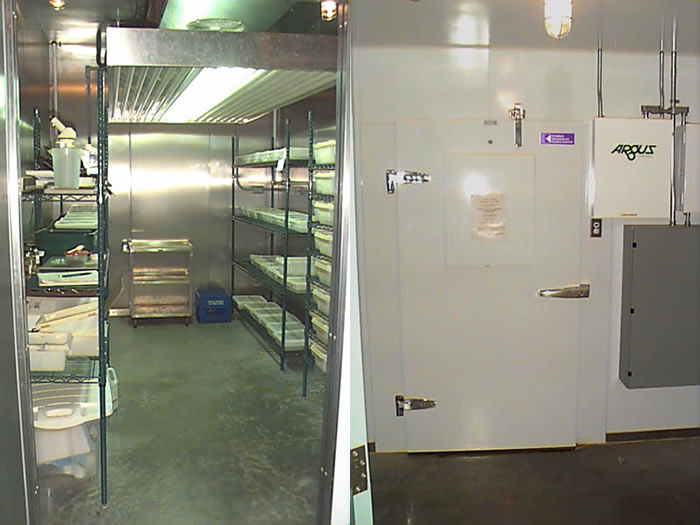Room 160a: Richard & Jean Ivey Room

Located in the General Holding Room, this chamber has an area of 9 m². High intensity lights, temperature and humidity are controlled by the computer system.
The door has a covered window built into it to allow inspection of the room without entry. The door covering the window should remain closed at all times while not in use. There is no handle located on the inside of the door.
To exit the room push on the left side of the door until it opens.
There are no catches to hold the door closed, only a mechanical door closure. There is provision to lock the door. If the door were to be locked while someone was still in the room, a release mechanism is located on the wall inside the room beside the door. Turn the handle to the right and push on the left side of the door until it opens.

Lights: Lighting is provided by a fluorescent lighting canopy with eighteen bulbs configured into six stages of lighting and two incandescent lights in weatherproof fixtures. This room has a fully programmable photoperiod (i.e., the photoperiod can be programmed to emulate that found at any latitude in the world or any artificial photoperiod that the researcher requires). At “dawn” the incandescent bulbs slowly ramp up to full intensity, then the fluorescent lights turn on sequentially in up to six steps if necessary. At “dusk” the process reverses with the incandescent bulbs slowly ramping off at “sunset” The time required to ramp to full intensity and the final intensity of the lights is programmable. The Photoperiod Alarm is set to activate if the lights do not turn on or off as the program requires.
Temperature control: Air temperature for this room ranges from 5°C - 25°C and is controlled by the Argus™ system. Temperature is fully programable. Temperature is monitored by a thermistor located within the room. The Air Temperature Deviation Alarm can be set to activate with as little as ± 1°C change.
Humidity Control: Room 160 a has two jets to add a fine mist of water to the room. Humidity is additive only and fine control is not possible at this time.
Power: This room has four 115 V electrical circuits. They are located around the perimeter of the room. Each circuit is protected by a duplex ground fault receptacle. If power is lost to a receptacle, check the buttons located in the middle of the receptacle. If one is sticking out, press it back in to reset the power. If power is lost again, report it to Aqualab personnel. A circuit breaker panel is located on the wall outside the chamber. Please do not open this panel without proper authorization.
Water: Raw water is supplied to this room. A 1" water line can be located in the south east corner of the room. A floor drain was added to this room to provide drainage. The drain is not “trapped” and connected to the floor drains for rooms 160b and c. these drains empty into the trench drain in room 160.
Aeration: Low pressure air is supplied through PVC pipes along each side wall. At the current time there are 24 outlets for air, however, more can be added as the need presents itself.
Alarms: There are a number of parameters within the room that can be alarmed. As previously mentioned, there is an alarm for photoperiod and air temperature deviation. There is also a Control Override for the chamber itself. If the air temperature rises above 28°C or drops below 15°C, the control system will cut all power to the chamber. Immediately the system will go into the highest alarm state and activate the Control Override Alarm, an audible alarm and the auto dialer will be activated to notify personnel of the problem. Power will be restored when air temperature returns to normal or by the Facility Manager. Operating in conjunction with the control override are manual temperature controllers. These manual controllers also act to cut power to the chamber during times of temperature extreme. These manual controls need to be reset after environmental conditions are changed usually at the beginning of new experiments. There is also a Low Air Pressure Alarm on the regenerative air system.